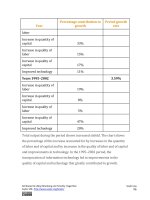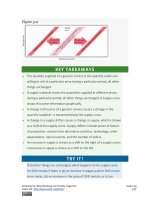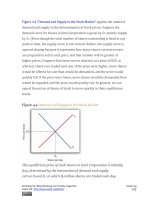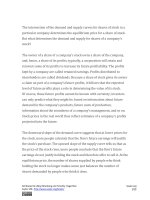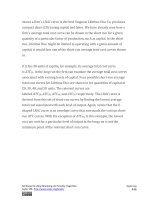Authors libby rittenberg 488
Bạn đang xem bản rút gọn của tài liệu. Xem và tải ngay bản đầy đủ của tài liệu tại đây (416.03 KB, 1 trang )
the one at which marginal cost equals marginal revenue would produce
even greater losses.
Suppose Mr. Gortari were to shut down and produce no radishes. Ceasing
production would reduce variable costs to zero, but he would still face
fixed costs of $400 per month (recall that $400 was the vertical intercept
of the total cost curve in Figure 9.6 "Total Revenue, Total Cost, and
Economic Profit"). By shutting down, Mr. Gortari would lose $400 per
month. By continuing to produce, he loses only $222.20.
Mr. Gortari is better off producing where marginal cost equals marginal
revenue because at that output price exceeds average variable cost.
Average variable cost is $0.14 per pound, so by continuing to produce he
covers his variable costs, with $0.04 per pound left over to apply to fixed
costs. Whenever price is greater than average variable cost, the firm
maximizes economic profit (or minimizes economic loss) by producing the
output level at which marginal revenue and marginal cost curves intersect.
Shutting Down to Minimize Economic Loss
Suppose price drops below a firm’s average variable cost. Now the best
strategy for the firm is to shut down, reducing its output to zero. The
minimum level of average variable cost, which occurs at the intersection of
the marginal cost curve and the average variable cost curve, is called
theshutdown point. Any price below the minimum value of average
variable cost will cause the firm to shut down. If the firm were to continue
producing, not only would it lose its fixed costs, but it would also face an
additional loss by not covering its variable costs.
Attributed to Libby Rittenberg and Timothy Tregarthen
Saylor URL: />
Saylor.org
488
